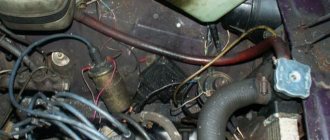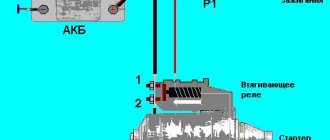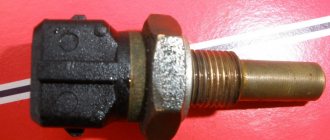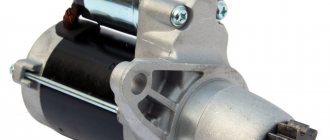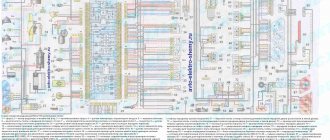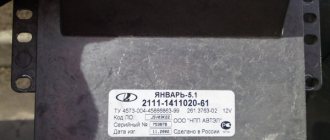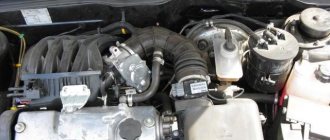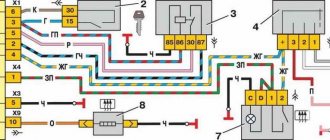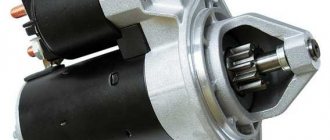Quite often, owners are interested in why the car does not start during startup, even though the starter turns as it should. It is worth noting that such problems usually arise with products from the Volzhsky Automobile Plant.
Quite often the following happens - the VAZ-2115 seizes, but does not start. As practice shows, such a nuisance usually occurs at the most inopportune moment, when the car is far from car services. Such a breakdown can occur at any time of the year, and under a variety of circumstances.
It is for this reason that any car owner needs to know why this happens and how to fix the problem. In fact, in some cases, failure to start the engine is caused by a fairly easily repairable breakdown that even an inexperienced driver can handle.
Why does the VAZ-2115 catch but won’t start and what to do
Quite often, owners are interested in why the car does not start during startup, even though the starter turns as it should.
It is worth noting that such problems usually arise with products from the Volzhsky Automobile Plant. Quite often the following happens - the VAZ-2115 seizes, but does not start. As practice shows, such a nuisance usually occurs at the most inopportune moment, when the car is far from car services. Such a breakdown can occur at any time of the year, and under a variety of circumstances. It is for this reason that any car owner needs to know why this happens and how to fix the problem. In fact, in some cases, failure to start the engine is caused by a fairly easily repairable breakdown that even an inexperienced driver can handle.
Ignition
When a car does not want to start, then most likely there is a problem in its ignition system. This reason, as practice shows, is extremely common. Most often, the lock breaks; somewhat less often, troubles occur with:
- coil;
- starter and its relay;
- battery.
Interestingly, a low battery usually does not interfere with a hot start, but in winter even a full charge may not be enough. Check the voltage supplied by the battery with a tester - normally it should be approximately 11.5 volts.
The problem in question often arises precisely because of the ignition switch. Here, contact deteriorates over time, and this, in turn, does not allow the system’s electrical circuit to be activated. It’s easy to check the functionality of the 2115 model:
- unscrew the lock from the panel;
- turn the key;
- use a tester to test all wires.
If there is no contact, the element is replaced.
Please note that if you do not hear a clunking noise when starting the car, then the ignition relay is most likely broken. It is located in the 2115th model near the driver's door, above the clutch. The element cannot be repaired; it must be replaced.
The ignition coil is checked separately - due to its failure, in particular, the spark on the spark plugs disappears. For testing, the unit must be dismantled. Next, use a multimeter to ring the windings. A short circuit in them or a break is a completely obvious reason explaining the reluctance of the car to start.
The car seizes, but the engine cannot start
Most often, this problem occurs in the cold, in the morning, after the car has spent the night in the open air or in an unheated garage. This often results from insufficient vehicle maintenance.
Troubles of this kind happen equally with both carburetor and injection machines. There are many reasons for refusal. Most often they are the following:
- any malfunction of the fuel supply system;
- electrical equipment failure.
It is important to always remember that starting an engine in winter differs in many ways from the same procedure carried out in the warm season.
Fuel system
As you know, the method of supplying fuel to carburetor and injection power units is different.
Nevertheless, the faults that manifest themselves are largely identical. In particular, in both cases gasoline is supplied using a pump. If in the first this unit operates on a mechanical drive, then in the second on an electric drive, which creates a fairly high pressure in the fuel supply system.
Both pumps have filter meshes in their design that purify gasoline. If they become clogged, the engine will not be able to start.
In addition, the pump electric motor fails if:
- no food;
- there was a wiring break;
- no mass added;
- The fuse has blown.
A carburetor unit will not start if the jets are clogged. Nevertheless, experience proves that most often cars driven by injection engines cannot start due to problems with the fuel system. The thing is that the design of such engines includes several special sensors that supply data to the on-board computer.
For example, if the DPKV fails, then the car will almost certainly not move. Similar problems occur due to a breakdown of the fuel pressure regulator. Engine injectors may also be to blame.
Failure of the fuel pump is detected quite simply. After turning on the ignition, you need to listen in the area of the rear seats to see if you can hear the characteristic sound of this important unit starting up.
Electricity problems
If fuel is supplied to the engine, but starting does not occur, you should look for an electrical failure.
First of all, you need to inspect the ignition. May not work:
It never happens that all nodes fail at the same time, so it is necessary to talk about each of them in more detail. In particular, if there are no problems with the ignition distributor, then most likely there is a breakdown of either the slider or the cover. The engine may not start due to a Hall sensor failure.
But the most common problem is improper contact at the supply terminal of the ignition distributor. However, the problem often arises due to the inability of the coil to produce the required voltage. As you know, the injector works together with the ignition module. There are two of them in the engine design. The first is in charge of the functioning of the 1st and 4th cylinders, the other, respectively, of the second and third.
As a result, even when the spark plugs are dry, a spark does not appear on them.
It may well be that the problem arose in the ECU, since it is in charge of generating commands for each installed system, and ignition is no exception. The only way to check the functionality of the on-board computer is to replace it with a known working unit. The suitability of the ignition module is checked in the same way.
If, however, a breakdown occurs in the coil, then a fairly simple test will allow you to verify its malfunction. The spark plugs are unscrewed from their sockets without removing the wires and placed against the ground of the car. Next, turn the starter. If a spark does not appear, it means that the coil has become unusable and cannot produce enough voltage to ignite the fuel.
It is also worth pointing out that the reason why the car does not want to start sometimes lies in the spark plugs themselves. It is this element that is responsible for the ignition of the fuel-air mixture. During operation, their metal parts burn out, which leads to an increase in the gap. The latter circumstance often either complicates the launch or makes it impossible. You should check the gap more often, and then no problems with the spark plugs will arise.
Source
Starter failure
If all other system components are in order, then the reason for the inability to start may lie in the absence of a starter. Typical problems:
- poor contact at the terminals;
- the starter shaft bearing has failed;
- The solenoid relay has stopped working.
It should be noted: the location of the power terminals on the starter suggests the presence of moisture. Therefore, often the contact simply oxidizes, which leads to problems in the operation of the device. That is why you need to carefully examine the contacts. Then clean them and check the voltage. If it is missing, there may be a break in the wiring.
When there is voltage, but the starter does not turn, it is often a problem with the bearings. To replace it, you will need a clean garage, as well as a special puller. This is the only way to dismantle it.
A little more often than a bearing, the solenoid relay fails. Sometimes it just jams - just tap it lightly with the key.
It is very simple to check the functionality of the retractor - just place the starter on the engine block and then touch the contact of the wiring relay connected to the positive terminal. If the starter starts spinning, it means the solenoid relay is in working condition. All of the problems listed above are typical and do not require any major repairs.
Fuel system
If it is below -20 degrees outside the window, it is possible that condensation has formed in the tank. The presence of water in gasoline is a bad sign. Moreover, it is not necessary that it be “diluted” at the gas stations themselves. Due to the temperature difference, condensation forms on the walls of the tank. At low temperatures it freezes. As a result, the VAZ-2115 (injector, 8 valves) does not start. Frozen water can be both in the fuel lines and in the filter itself. There is no point in trying to turn the starter with the hope that the car is about to start. You'll just drain the battery. The only solution to the problem is to warm up the car. It's better if it's in a garage with this problem. By installing an oil or induction heater there, you will quickly warm up the air temperature in the room. And the car will start successfully.
Starter
In a situation where the car does not start, and the previously described components are in order, then a faulty starter is probably preventing normal starting. This could happen to him:
- poor contact in the wiring;
- breakage of the solenoid relay;
- destruction of the bearing on which the assembly shaft rotates.
The terminals of the cables connected to the starter often become oxidized and dirty. This is the most possible factor preventing the VAZ car of the model in question from starting. If cleaning does not help, then it is possible that there is a break somewhere.
Bearings, as well as brushes and windings are checked when it turns out that voltage is supplied to the starter, but it does not turn. It will have to be removed and disassembled. And sometimes the solenoid relay fails. More often than not it just jams. It helps to bring the device back to life by gently tapping it, for example, with a key.
In general, it is not difficult to find out whether the relay of your VAZ-2115 is functioning. Connect its positive output directly to the corresponding wire coming from the battery.
Clogged filters
This problem can occur in both summer and winter. And this applies not only to the fuel filter, but also to the air filter. The latter is in a special plastic case. On VAZ 15th model cars it looks like this.
After moving the latches, lift the air filter housing cover and remove the cleaning element itself. If it is dirty, the part needs to be replaced. Filters are consumables and cannot be restored at home. Moreover, they cost pennies. As for the fuel filter, it is located under the bottom of the car. The element looks like in the photo below.
If the car has driven more than 30 thousand kilometers, the filter should be replaced. You will not be able to visually determine the degree of contamination as you can in the air. The part is located in a closed, non-separable case. It has porous paper inside. It is capable of passing particles smaller than 10 microns. Over time, the pores of the paper become clogged, and the filter is not able to pass the required amount of fuel through itself. So that the problem does not take you by surprise, change this part in advance.
A characteristic sign of failure is jerking when moving (as if the fuel supply to the cylinders had stopped for some time). This means that the submersible pump is not able to supply the required amount of fuel through the paper pores. As for the air filter, it is changed every 6 months or every 10 thousand kilometers. By following the regulations, you will protect yourself from such problems.
Frequent malfunctions on popular cars
In most cases, the starter does not turn when the ignition key is turned due to oxidation and mechanical damage to the wiring. If there is poor contact with the “+” terminal of the battery, the control relay or ground, the starter does not receive enough current to crank the engine . Therefore, first of all, you need to look at the contacts in the engine compartment and check for voltage at the terminals with a tester. The most common malfunctions of specific car models, due to which the starter does not respond to the ignition key in the table.
| Why does the starter not work from the ignition key on popular car models? | |
| Auto | Weakness |
| VAZ 2110, 2111, 2112 | Wires of the central locking and ignition switch, which melt due to power surges. |
| VAZ 2108, 2109, 21099, 2113, 2114, 2115 (Lada Samara) | Oxidizing contacts of the control relay located in the engine compartment above the VUT, as well as the wiring extending from it. |
| VAZ 2101, 2102, 2103, 2104, 2105, 2106, 2107 (Classic) | The contact “nickels” of the solenoid relay often burn or oxidize. The contact group of the ignition switch fails. On later models, for example, 2107, problems with the control relay are similar to Samara (see above). |
| Niva | On old Nivas (before 21213), the ignition switch contacts burn and oxidize. On newer ones (after 21214), the starter control relay, located under the hood near the brake fluid reservoir, often fails. There is a drainage tube located nearby that drains water from under the glass, moisture from which gets onto the relay, which leads to oxidation of its contacts. |
| Lada Priora | Immobilizer problems due to which it does not see the key. |
| Lada Kalina, Lada Granta | Failure of the immobilizer, blocking the start, malfunctions in the contact group of the ignition switch and failure of the additional starter relay K3 in the fuse block. |
| UAZ | Malfunction of the 5-pin starter control relay and solenoid relay. |
| Gazelle | Poor contact of wires and failure of the starter relay. |
| Peugeot 307 | Solenoid relay fuse F8 blows, poor ground contact. |
| Kia Sid | The limit switch of the automatic transmission selector, which determines the P and N positions, is faulty. There may be poor contact at the starter terminals or at the point where the ground wire is attached to the body. |
How to solve a problem?
There are two ways to solve this problem:
- On the spot. If you don't have time to remove the spark plugs, you can try drying them directly in the engine. To do this, open the throttle valve 50 percent before starting. Fortunately, on the VAZ-2115 the accelerator pedal is mechanical, with a cable drive. This will allow more air to enter the combustion chamber. The candles are “blown out” automatically. After starting, the throttle valve can be closed. But this method is not always effective. And then the second method comes to the rescue.
- Self-drying. In this case, all four spark plugs are unscrewed. An important point - when removing armor wires, number each of them. Otherwise, the engine will not start at all, since the valve timing will be disrupted. You can quickly dry it with a home hairdryer, setting it to maximum blowing mode. If time permits, you can check the gaps between the electrodes of the spark plugs. When this parameter does not match the factory setting, the spark plug cannot produce a normal spark. We talk about this in more detail.
Other reasons for the inability to start the engine
Figuring out why the engine stalls is not difficult. In addition to typical problems, the following types of problems may be present:
- timing belt is broken;
- the engine “knocked”;
- the shaft is jammed.
A fairly common problem, especially on 16-valve engines, is a broken timing belt. In this case, the valves on the VAZ 2115 bend. Such breakdowns not only lead to the inability to start the engine. But they require a complete engine overhaul. The situation is similar if the engine knocks. If you can’t start the car even when it’s hot, you should check the air supply channel. Moreover, starting is not always possible the first time.
There are many nuances associated with setting the ignition and ensuring normal engine operation. You will need to carefully understand all the subtleties and nuances. Many problems associated with the inability to start the VAZ 2115 engine are associated with typical malfunctions and repairs take a minimum of time.
About spark plug gap
Over time, the gap between the electrodes increases. The normal parameter is from 0.7 mm to one millimeter. You can check this gap using a special feeler gauge.
The same is used for setting valve clearances on carburetor engines. So, if a parameter does not meet the norm, it should be adjusted. To do this, you should use a negative screwdriver. To reduce the gap, press the end of the plug onto the top electrode of the spark plug. With your other hand, hold the part itself. If you “overdid it”, it doesn’t matter – everything can be returned back. To do this, bend the electrode with the edge of a screwdriver (it bends quite easily) and check the distance again. It is worth noting that with a correctly set gap, you can not only ensure trouble-free engine starting, but also reduce fuel consumption by 5 percent. Also the car will run smoothly. After all, the mixture is ignited exactly at the moment when it is necessary. And the last thing is the resource of the candles themselves. If the gap is higher or lower than normal, the risk of breaking through the insulator increases significantly. As for the replacement schedule, it is about 40 thousand kilometers. It is recommended to replace the high-voltage wires along with the spark plugs.
Coil
Modern cars are no longer equipped with distributors. There is an ignition module here. VAZ-2115 (16 valves) is no exception. Sometimes breakdowns happen. Because of this, the VAZ-2115 does not start. The reasons are a faulty ignition distributor.
This item cannot be repaired. And in order not to waste time on diagnostics (or if you don’t have a multimeter), it’s worth installing a known-good ignition module. The VAZ-2115 should start without difficulty. Sometimes the high-voltage wires themselves pierce. But in this case the car starts and starts. This can be heard by the characteristic sound of the engine.
The starter turns, but does not start: VAZ carburetor
A common failure on classic models. There may be three reasons for this:
- ignition;
- air and fuel lines;
- carburetor.
However, during repairs it is necessary to check both branches.
Ignition failures
Failure to supply a spark is one of the causes of failure. The sequence of actions looks like this.
- Checking the spark on the spark plugs. The element is unscrewed from its socket. Next, without removing the cap from the stud, you need to attach the spark plug to the engine block and crank the starter. If at this time a powerful spark appears on the electrode, the part is in good condition. The procedure must be repeated for all pistons. If there is no breakdown, the element is replaced with a new one.
- Circuit breakers. Burnout of fusible links is common among carburetor cars.
- High voltage cables. If replacing the spark plug does not help (there is still no spark), the armored wires need to be checked. The ideal option would be to diagnose by replacing the cable with a known good one.
Note! Checking armored wires and spark plugs is carried out in a dark room. If the cable or spark plug body is broken, the electric arc can jump anywhere in the line.
In some cases, the car may not start due to loose starter wiring, battery or battery discharge.
Air and fuel supply
The next reason why the starter turns, but the car does not start may be due to a malfunction in the supply of the combustible mixture. The sequence of actions looks like this.
- Initially, the filter elements, air and fuel, are checked. Interruptions in the supply of gasoline or air are the primary source of the problem, when the starter turns, seizes, but does not start - clogged inserts prevent the free flow of fluid.
- The next stage is the fuel pump. When cranking the starter, you need to listen to the details. If the unit does not pump fuel, starting the engine will be impossible.
Note! In some car models (VAZ 2101/06), a common cause of breakdown, when the starter turns but the car does not start, is overheating. To eliminate the defect, simply moisten a rag with cold water and wrap it around the pump. After cooling, the car will start.
Carburetor
If all manipulations with the lines and the fuel supply system have not brought results, the next step is to check the cleanliness and accuracy of the carburetor settings.
The mechanism is riddled with thin passages and bypass valves. If low-quality gasoline gets in, the channels quickly become clogged and block the movement of liquid. During repairs, the carburetor is completely disassembled and the jets are cleaned - this is best done with compressed air or thick fishing line. It is also necessary to blow out all the holes, after rinsing the structure with clean gasoline. After cleaning, the mechanism is assembled in the reverse order.
Note! During repairs, special attention must be paid to the throttle valve and jets - these elements are most often the source of trouble.
The starter turns but does not start: injector
When the starter turns, but the VAZ 2114 does not start, it has 8 or 16 valves (also relevant for similar car models). The problem is searched for in the following systems:
- fuel supply;
- ignition;
- electronics;
- injector.
Fuel system
A common problem when injection vehicles fail to start is a breakdown of the fuel pump. When you turn the key in the ignition switch, a characteristic hum should be heard from the tank, accompanied by pumping gasoline into the line. If it is absent, the corresponding relay and fuse are checked. If the inserts are in good condition, it is necessary to diagnose the pump itself (located inside the tank, under the rear seats). It is also necessary to check the integrity of the fuel lines and the working condition of the coarse and fine filters.
Gasoline quality
There is a widespread belief that a properly tuned engine can operate even on surrogate gasoline without causing problems - this is fundamentally not true. If the starter turns but the Priora or a similar car does not start some time after the last refueling, the problem may be with bad fuel. This mixture must be drained and filled with new fuel as quickly as possible.
Injectors clogged
In 90% of cases, the problem arises as a consequence of a previous incident. The nozzle nozzle has a minimum diameter. The smallest specks can clog the passage inside the part, which causes failure of the power unit or tripping.
You can check it like this. After 2-3 unsuccessful attempts to start the engine, you need to unscrew the spark plugs. If the electrodes are wet, the injectors work.
Note! Fuel injectors do not fail at the same time. A secondary sign of device failure is that the car is running rough before starting problems.
Repairs and thorough diagnostics of parts are carried out on a special stand.
No pressure inside the fuel rail
The starter turns, but the 2114 VAZ or Priora does not start - the reason may be due to insufficient operating pressure of the injector fuel rail. If the fuel pump is operating adequately, it is necessary to check the mass air flow sensor. A faulty unit may send incorrect information to the ECU, which prevents the combustion mixture from forming correctly. In some cases (5-6%), the launch is affected by the failure of the TPS. However, this is unlikely.
Electronics and ignition
Initially, spark plugs are diagnosed using the standard method. If there is no spark, the spark plugs themselves and the high-voltage wires are checked. If everything is in order, but there is no expected arc, the problem may be in the following nodes.
- Ignition module. A capricious and unpredictable detail on most VAZ family cars and budget foreign cars. The block design is practically beyond repair; upon diagnosis, it is replaced with a known good one. It is also important to have voltage on the module chip. If there is no electricity, the fuse and the corresponding relay are checked.
- DPKV - the sensor may transmit data with an error or completely fail. This is a key element of the ignition system; performance testing is performed with an oscilloscope. Also changes to a known good one.
- ECU. The injector control design may malfunction due to oxidation of the contact chips or internal problems.
- System errors. Accumulated failures of the on-board computer may prevent the engine from starting. The problem can be eliminated by diagnostics at a service station with specialized equipment.
- Mechanical failures. Broken wires, oxidized terminals or loose connections in 50% of cases lead to interruptions in the operation of the internal combustion engine.
Fuel supply: fuel pump failure and other reasons
If all of the above problems are absent, then you should check the performance of the fuel system. Often the reason lies in the following:
- the fuel pump has failed;
- low pressure level in the fuel line;
- the filter is clogged;
- the injectors are out of order;
- low pressure in the ramp.
You need to remember: it is quite difficult to check the performance of the fuel pump on cars with an injection engine. You can determine its performance by its sound - immediately after turning on the ignition, it should definitely make noise. If the fuel pump is faulty, it will need to be replaced. Such devices do not require repair.
You should check the pressure level in the fuel line and rail. To do this you will need to use a special pressure gauge. The normal pressure level for VAZ 2115 and VAZ 2114 is from 2 to 2.5 atm.
If this indicator is lower than specified, then the car will have poor grip and stall while driving. In this case, it will be difficult to fix the problem yourself. It is worth contacting a car service. It often leaks at the ramp connection point.
When a car has a high mileage and uses relatively low quality fuel, the problem often lies in a clogged filter. It needs to be replaced. The cost of a filter is usually no more than 250-300 rubles. Often the problem is also due to poor quality fuel in the injectors - they are simply clogged. Moreover, in some regions, even branded gas stations sell relatively low quality fuel.
Cleaning them requires special equipment. But often the injectors do not cope with their function due to lack of power. Checking its presence or absence is relatively simple - just disconnect the special connector and use a tester.
As in the case of measuring the voltage on the battery, you need to set the measurement limit to 20 V. The voltage should be 12 V. Lack of power indicates the need to check the wiring for an open circuit.
In some cases, the problem lies in armored wires and candlesticks. It is enough to replace the power cables that supply voltage from the coil to the spark plug - and the motor begins to operate smoothly and unpretentiously.
The starter turns, but does not start: diesel
The design of diesel cars differs from classic gasoline units. Here, ignition of the combustible mixture occurs according to a different principle, which imposes its own criteria for diagnosing the power plant.
Among the most common problems are the following. Lack of glow The most common problem is burnout of the glow plug electrode. Checking spark plugs is carried out exclusively using special equipment. Failure of one element causes tripping or popping noises during engine operation. If the parts themselves are functioning properly, the reason may be hidden in the armored wires or power relay.
Note! Part failure can occur while the car is moving. Due to the sufficient temperature of the combustion chamber, problems begin only after the block has cooled.
Incorrect fuel supply A common problem in winter is diesel freezing or waxing of filter elements. In this case, it is necessary to change the cleaning grids and warm up the machine in a warm box. If it happens in the summer, the search for the “root of evil” is done like this.
- Incorrect operation of anti-theft equipment - the alarm is turned off or repaired.
- The condition of the main pump and the integrity of the fuel lines are checked. If a hose or tube leaks, air may be sucked through the crack, causing a problem.
- The injectors are unscrewed from the internal combustion engine block and tested on special stands. Often the pressure hole becomes clogged after pouring low-quality fuel or driving over potholes - sediment rises from the bottom of the gas tank and enters the engine.
- If the starter turns, but the engine doesn’t even start (there is also no smoke from the exhaust pipe), it means that diesel fuel is not entering the cylinders at all. The first step is to check the serviceability of the high pressure fuel pump (HPF) and its drive pump.
- Next, all lines for each injector are diagnosed individually.
- Calibrating the diesel feed angle. The injection pump belt may jump or break, which will cause incorrect fluid injection.
Common problems
Also, the reason that the starter turns but the engine does not start are common problems that are typical for all cars, regardless of the type of fuel consumed or its supply pattern. The main ones are: Jamming of attachments Jamming of the power steering drive, generator or coolant compressor.
A stalled unit may prevent the crankshaft from turning. When starting the engine, you need to check whether all the pulleys rotate freely. Reduced compression Loss of the required pressure inside the working cylinders can cause the combustible mixture to leak into the crankcase or exhaust manifold. There may be several sources here.
- Occurrence of piston rings. Tired seals can coke or even burst, which will certainly lead to a loss of nominal pressure.
- Worn or elliptical cylinders. This is an extreme case when a major overhaul of the internal combustion engine is required.
- Bent or defective valves. Inserts may break off or not fit tightly to the cylinder head.
- Timing belt rupture is a precursor to the above case.
- Formation of defects of thermal or mechanical origin. This includes cracks, chips or scratches in the block caused by overheating of the cylinder head. Also a violation of the design of the crankshaft and its fastenings (liners, connecting rods, pins).
- The worst reason is engine jamming (the engine knocked). In this case, a complete replacement of the unit is required, which entails costs comparable to 50% of the cost of the car.
- The most comical situation is that there is simply no fuel inside the tank. As a rule, this is caused by a malfunction of the float or the corresponding sensor. The problem is treated by visiting a gas station.
There can be many reasons why the starter turns but the engine does not start. A qualified mechanic or car enthusiast with extensive experience can quickly and accurately find the “root of evil.”
Source
Other reasons
Malfunctions of this kind are much less common on the VAZ-2115:
- crankshaft jamming;
- timing belt rupture;
- wear of cylinder gaskets.
In the first and last case, you will have to disassemble the engine and replace unsuitable parts. If you are not sure that you can cope with this task, then it is better to entrust it to specialists from a car service center. It’s quite possible to install the belt yourself.
Sometimes problems in the VAZ-2115 arise with hot starts. There is a possibility that the air filter is the culprit. Check it and the lines that are connected to it.
Sources
- ladaprofi.ru/vaz-2115/chto-delat-esli-vaz-2115-ne-zavoditsya.html
- zen.yandex.ru/media/avtovaz/ne-zavoditsia-avtomobil-vaz-2115-5abf28eea815f1eea1996207
- ladaautos.ru/vaz-2115/pochemu-vaz-2115-sxvatyvaet-no-ne-zavoditsya-i-chto-delat.html
- zapchasti.expert/reshenie-problem/ne-zavoditsya/ne-zavoditsya-vaz-2115.html

